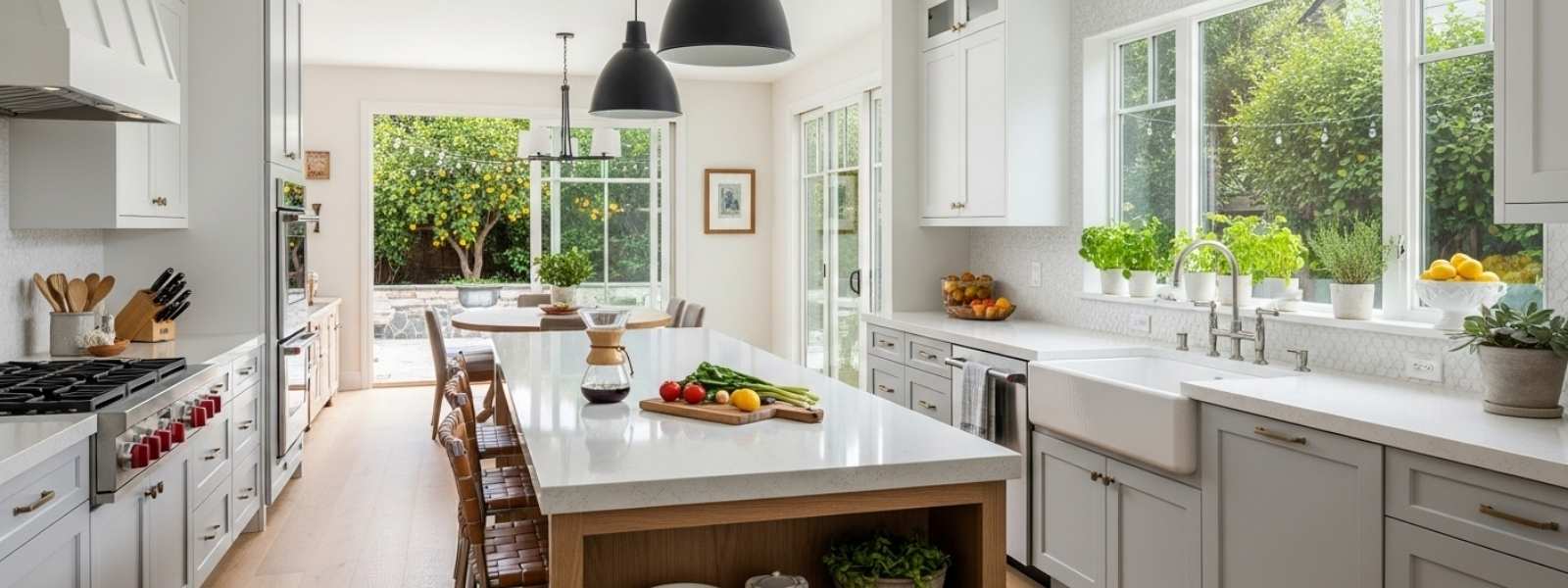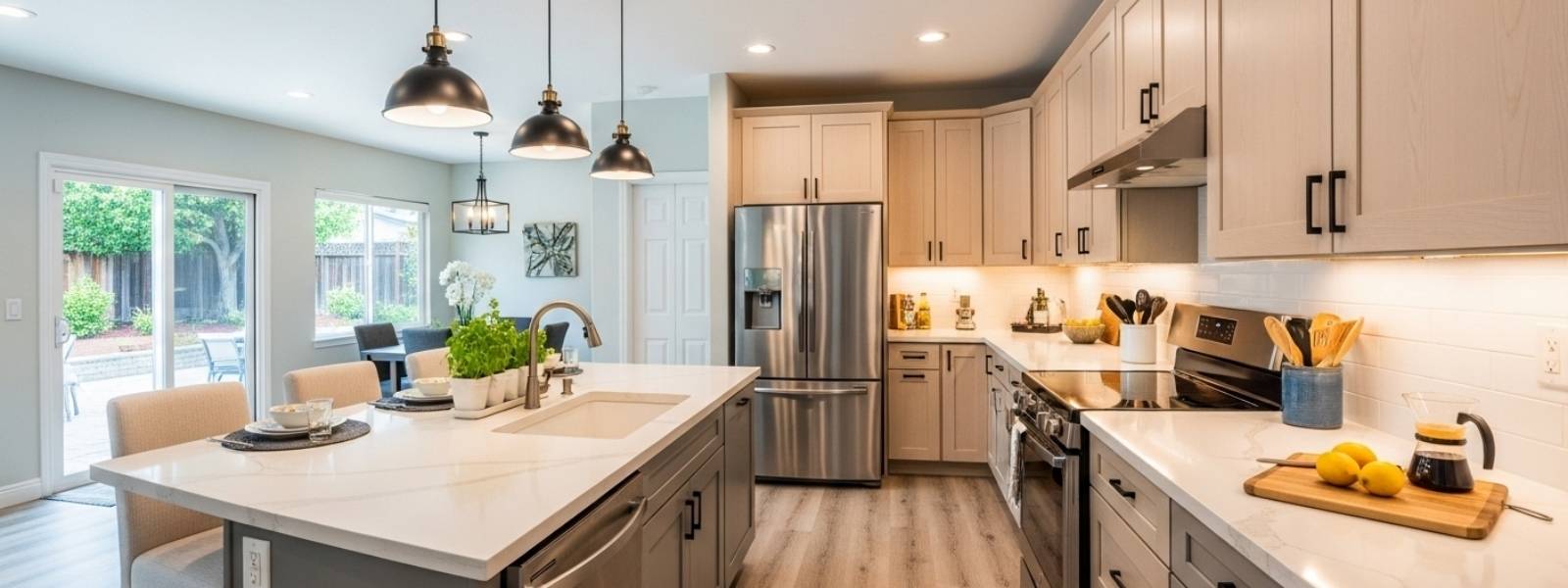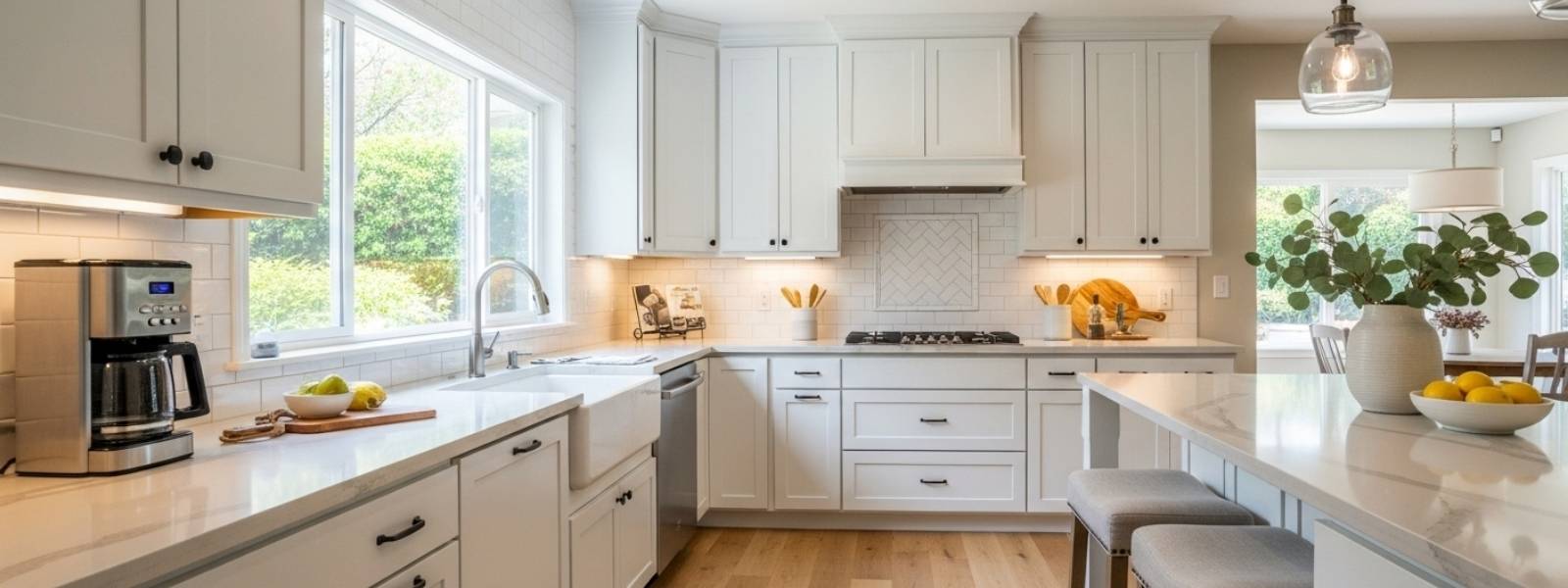
When buyers walk into a home, the kitchen is often the first room that makes or breaks their impression. A bright, functional, and updated kitchen signals that the home is well cared for and move-in ready. On the other hand, an outdated space can make even the rest of the house feel less appealing. That’s why the kitchen has become one of the most important drivers of home value.
Remodeling this space is more than a cosmetic upgrade. It improves daily life for the people living there and also acts as a financial investment that pays off at resale. From better storage and smarter layouts to modern finishes and energy-efficient appliances, a kitchen remodel combines comfort with long-term value.
Recent data shows just how powerful this investment can be. On average, homeowners recover about 60% to 75% of their costs when selling after a remodel. In many cases, smaller, well-planned updates provide the best return, proving that you don’t need a luxury overhaul to make a big impact on value.
Understanding Kitchen Remodel ROI
Before starting a kitchen renovation, it helps to know how much of your investment you are likely to get back. Remodeling a kitchen not only improves your daily living experience but also impacts your home’s resale value.
1- National vs. Local ROI Averages
Across the United States, kitchen remodels typically return 60% to 75% of their cost at resale. In many California markets, including the San Gabriel Valley, buyers place high importance on updated kitchens, which often makes the return even stronger. A refreshed kitchen can also help a home sell faster compared to similar homes with outdated designs.
2- Minor vs. Major Remodel Returns
The scale of the renovation has a big impact on ROI. Minor remodels such as cabinet refacing, new countertops, fresh paint, and upgraded appliances tend to deliver the best value. These updates create a modern look without the high expense of structural changes. Major remodels, which include custom cabinetry, layout changes, and luxury finishes, can be visually impressive but usually return a smaller percentage of the investment because of their higher upfront cost.
3- The Role of Home Price Brackets
Your home’s value also shapes the return. In mid-range homes, buyers expect modern and functional upgrades, so modest remodels usually bring the strongest ROI. In high-end properties, premium finishes and high-tech appliances may be expected, but the added expense often doesn’t deliver the same percentage return. Matching your renovation choices to the expectations of your neighborhood is the best way to balance cost with value.
Important Upgrades That Adds to Your Property’s Value
1- Cabinetry
Cabinets often set the tone for the entire kitchen. Refacing existing cabinets is a budget-friendly way to modernize the space while keeping the current layout. Replacing them with new stock or semi-custom cabinets provides more design flexibility and improves storage. Custom cabinetry offers a premium look but may not always deliver the highest return. Modern finishes like light woods, two-tone colors, or soft-close doors are especially appealing to today’s buyers. Since cabinetry is one of the first things people notice when entering a kitchen, updating it can significantly increase both aesthetic appeal and resale value.
2- Countertops
Countertops are a major focal point in any kitchen, and upgrading them often gives one of the best returns. Quartz is durable, low-maintenance, and very popular with buyers, making it a smart investment. Granite remains a classic choice for its natural beauty, while butcher block adds warmth and a touch of farmhouse charm. Marble looks luxurious but requires more upkeep, which can deter some buyers. Selecting countertops that balance style with durability helps attract interest when selling. Neutral colors with subtle patterns tend to appeal to the widest range of buyers, boosting overall home value.
3- Appliances
Appliances are another upgrade that buyers notice immediately. Stainless steel models remain highly desirable for their sleek appearance and ability to match most kitchen styles. Energy-efficient appliances are an even stronger selling point, as they save money on utility bills and meet California’s eco-conscious standards. Replacing outdated appliances with modern, reliable models makes the kitchen feel fresh and functional. While luxury brands may not always return their full cost at resale, mid-range, energy-efficient appliances deliver an excellent balance of buyer appeal and long-term savings, making them one of the smartest investments in a remodel.
4- Flooring
Flooring creates the foundation of the kitchen, and durable, timeless materials often bring the best ROI. Tile is a popular option because of its long lifespan and resistance to spills. Hardwood adds warmth and value but can be more costly to install and maintain. Luxury vinyl planks (LVP) have grown in popularity because they combine affordability, water resistance, and stylish looks. Buyers tend to prefer flooring that is easy to clean and complements multiple design styles. By investing in flooring that is practical yet attractive, homeowners can improve daily living while boosting their property’s resale appeal.
5- Lighting
Good lighting makes a kitchen both functional and inviting. Upgrades such as pendant fixtures, recessed lights, and under-cabinet lighting help brighten work areas while enhancing overall style. LED lights are energy-efficient and long-lasting, which makes them attractive to buyers who value both savings and sustainability. Lighting also creates ambiance, turning a plain kitchen into a warm and welcoming space. Adding modern fixtures that match the overall design can quickly update the room without a huge cost. Since well-lit kitchens feel more open and spacious, lighting upgrades often deliver excellent value during resale.
6- Layout Improvements
The layout of a kitchen is one of the biggest factors in how buyers judge its value. Open floor plans that connect the kitchen with dining or living areas are especially appealing because they create a sense of flow and make entertaining easier. Functional design choices, such as adding an island for extra seating and storage, or adjusting the work triangle for better efficiency, also improve daily usability. While layout changes can be more expensive, they can greatly increase buyer interest. A kitchen that feels open, practical, and well-planned often stands out in the market and boosts overall home value.
Design Choices that Appeal to Buyers
- Neutral Color Schemes: Whites, grays, and soft earth tones create a clean, bright look that appeals to most buyers. They make the kitchen feel larger and easier to personalize.
- Bold Colors: Can add personality, but may limit appeal to some buyers. Use sparingly through accents like bar stools, décor, or small appliances.
- Timeless Finishes: Shaker cabinets, quartz or granite countertops, and hardwood or classic tile flooring remain attractive over time and provide strong resale value.
- Trendy Finishes: Dark cabinets, metallic accents, or unusual textures can make a statement today but risk looking dated later. Pair them with timeless elements for balance.
- Small “Wow” Details: Upgraded hardware, stylish backsplashes, under-cabinet lighting, and modern fixtures elevate the kitchen’s look without major investment. These touches create a polished, memorable impression for buyers.
Budgeting for Value
Knowing how much to spend on a kitchen remodel is key to maximizing resale value. A common guideline is to allocate 10–15% of your home’s value for the renovation. For example, if your home is valued at $500,000, a kitchen budget of $50,000 to $75,000 is reasonable. This ensures you make meaningful improvements without overspending relative to the property’s overall worth.
It’s also important to distinguish between high-value and low-value investments. Upgrades like durable countertops, modern cabinetry, energy-efficient appliances, and quality flooring typically deliver strong returns. In contrast, overly luxurious finishes or features that exceed buyer expectations may not recover their cost at resale.
Finally, avoid over-improvement for the neighborhood. A kitchen that is too expensive or elaborate compared to nearby homes can make it harder to recoup costs. Focus on improvements that elevate the home to the local market standard while maintaining balance between style, functionality, and budget.
Mistakes That Lower ROI
- Overspending on luxury features that buyers may not value or pay for.
- Ignoring energy-efficient upgrades that save money and attract eco-conscious buyers.
- Hiring contractors without checking experience, licenses, or past work, which can result in low-quality construction.
- Failing to obtain necessary permits and approvals, leading to potential legal or resale issues.
- Choosing trendy designs that may look dated quickly, reducing long-term appeal.
- Skipping small but noticeable details, such as cabinet hardware, lighting, or backsplash updates.
- Underestimating hidden costs like delivery fees, disposal, or unexpected repairs.
- Not planning the renovation around your neighborhood’s typical home value, which can result in over-improvement.
Local Market Impact
Kitchen remodels can have a different impact on resale depending on your local housing market. In urban areas, buyers often expect modern, functional kitchens and may be willing to pay a premium for updated layouts and finishes. In suburban markets, practical features like ample storage, durable flooring, and energy-efficient appliances tend to drive more value. Understanding what local buyers prioritize helps homeowners make renovations that will appeal to the target audience.
Buyer expectations can also vary based on home price ranges and neighborhood trends. Homes in higher-priced neighborhoods may require premium finishes to stay competitive, while mid-range properties benefit more from well-planned, functional updates rather than luxury features. For example, minor remodels in suburban areas can sometimes offer higher ROI percentages compared to major, costly renovations in metro areas, where buyers may already anticipate a certain standard of upgrades. Aligning your remodel with these local expectations ensures your investment delivers the strongest possible return.
Conclusion
A kitchen remodel is one of the smartest ways to boost both comfort and home value. By focusing on updates that balance style, function, and budget, homeowners can create a space that appeals to daily life and future buyers. Key investments like cabinetry, countertops, appliances, and flooring deliver strong returns, while thoughtful design choices, neutral color schemes, and small finishing touches enhance overall appeal. Avoiding common mistakes, planning your budget carefully, and understanding local market expectations ensures that every dollar spent contributes to resale value. With careful planning, a well-executed kitchen remodel can provide lasting enjoyment and financial benefit.


